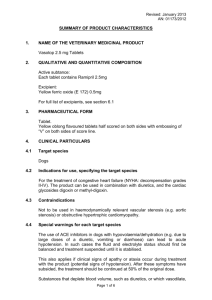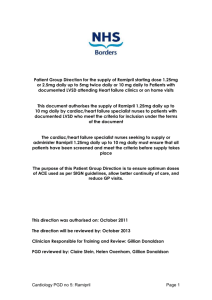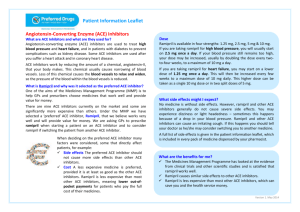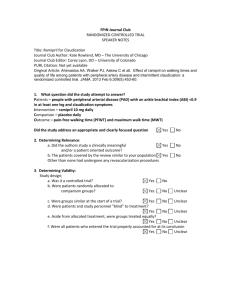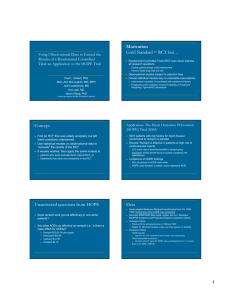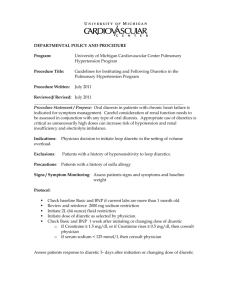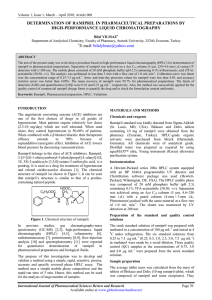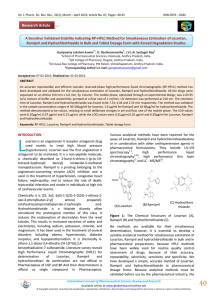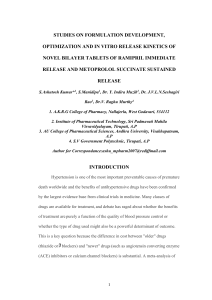Preface Tablets
advertisement
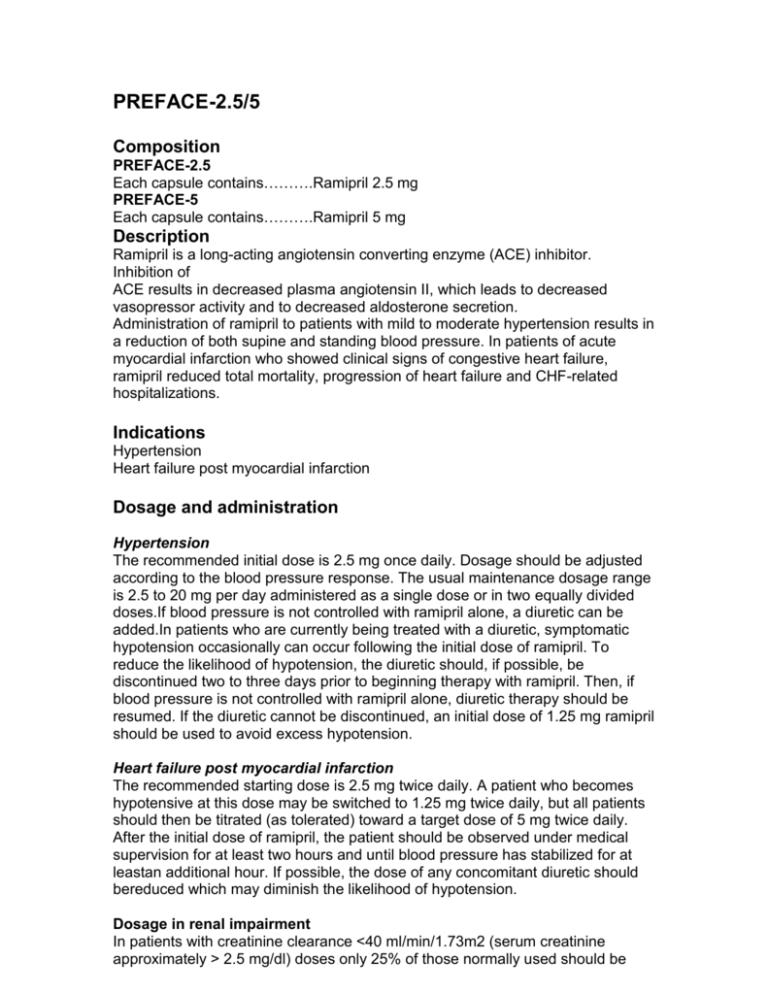
PREFACE-2.5/5 Composition PREFACE-2.5 Each capsule contains……….Ramipril 2.5 mg PREFACE-5 Each capsule contains……….Ramipril 5 mg Description Ramipril is a long-acting angiotensin converting enzyme (ACE) inhibitor. Inhibition of ACE results in decreased plasma angiotensin II, which leads to decreased vasopressor activity and to decreased aldosterone secretion. Administration of ramipril to patients with mild to moderate hypertension results in a reduction of both supine and standing blood pressure. In patients of acute myocardial infarction who showed clinical signs of congestive heart failure, ramipril reduced total mortality, progression of heart failure and CHF-related hospitalizations. Indications Hypertension Heart failure post myocardial infarction Dosage and administration Hypertension The recommended initial dose is 2.5 mg once daily. Dosage should be adjusted according to the blood pressure response. The usual maintenance dosage range is 2.5 to 20 mg per day administered as a single dose or in two equally divided doses.If blood pressure is not controlled with ramipril alone, a diuretic can be added.In patients who are currently being treated with a diuretic, symptomatic hypotension occasionally can occur following the initial dose of ramipril. To reduce the likelihood of hypotension, the diuretic should, if possible, be discontinued two to three days prior to beginning therapy with ramipril. Then, if blood pressure is not controlled with ramipril alone, diuretic therapy should be resumed. If the diuretic cannot be discontinued, an initial dose of 1.25 mg ramipril should be used to avoid excess hypotension. Heart failure post myocardial infarction The recommended starting dose is 2.5 mg twice daily. A patient who becomes hypotensive at this dose may be switched to 1.25 mg twice daily, but all patients should then be titrated (as tolerated) toward a target dose of 5 mg twice daily. After the initial dose of ramipril, the patient should be observed under medical supervision for at least two hours and until blood pressure has stabilized for at leastan additional hour. If possible, the dose of any concomitant diuretic should bereduced which may diminish the likelihood of hypotension. Dosage in renal impairment In patients with creatinine clearance <40 ml/min/1.73m2 (serum creatinine approximately > 2.5 mg/dl) doses only 25% of those normally used should be expected to induce full therapeutic levels of ramiprilat, the active metabolite of ramipril. Hypertension For patients with hypertension and renal impairment, the recommended initial doseis 1.25 mg ramipril once daily. Dosage may be titrated upward until blood pressure iscontrolled or to a maximum total daily dose of 5 mg Heart failure post myocardial infarction For patients with heart failure and renal impairment, the recommended initial dose is1.25 mg ramipril once daily. The dose may be increased to 1.25 mg twice daily and up to a maximum dose of 2.5 mg twice daily depending upon clinical response and tolerability. Contraindications Hypersensitivity to ramipril History of angioedema related to previous treatment with an ACE inhibitor. Warnings and Precautions Drug Interactions Diuretics: Patients on diuretics may occasionally experience an excessive reduction of blood pressure after initiation of therapy with ramipril. The possibility of hypotensive effects can be minimized by either discontinuing the diuretic or increasing the salt intake prior to initiation of treatment with ramipril. If this is not possible, the starting dose should be reduced. Potassium supplements and potassium-sparing diuretics: Ramipril can attenuate potassium loss caused by thiazide diuretics. Potassium-sparing diuretics (spironolactone, amiloride, triamterene and others) or potassium supplements can increase the risk of hyperkalemia. Therefore, if concomitant use of such agents is indicated, they should be given with caution, and the patient's serum potassium should be monitored frequently. Lithium: Increased serum lithium levels and symptoms of lithium toxicity have been reported in patients receiving ACE inhibitors during therapy with lithium. These drugs should be coadministered with caution, and frequent monitoring of serum lithium levels is recommended. If a diuretic is also used, the risk of lithium toxicity may be increased. ANGIOEDEMA Angioedema of the face, extremities, lips, tongue, glottis and larynx has been reported in patients treated with an ACE inhibitor. Patients with a history of angioedema unrelated to ACE inhibitor therapy may be at increased risk of angioedema while receiving an ACE inhibitor. HYPOTENSION Ramipril can cause symptomatic hypotension, after either the initial dose or a later dose when the dosage has been increased. Symptomatic hypotension is most likely to occur in patients who have been volume- and/or salt-depleted as a result of prolonged diuretic therapy, dietary salt restriction, dialysis, diarrhea or vomiting. Volume and/or salt depletion should be corrected before initiating therapy with ramipril. HEPATIC FAILURE Rarely, ACE inhibitors have been associated with a syndrome that starts with cholestatic jaundice and progresses to fulminant hepatic necrosis and (sometimes) death. Patients receiving ACE inhibitors who develop jaundice or marked elevations of hepatic enzymes should discontinue the ACE inhibitor. IMPAIRED RENAL FUNCTION As a consequence of inhibiting the rennin angiotensin system (RAS), changes in renal function may be anticipated in susceptible individuals. In patients with severe congestive heart failure whose renal function may depend on the activity of the RAS, treatment with ACE inhibitors may be associated with oliguria and/or progressive azotemia and (rarely) with acute renal failure and/or death. In hypertensive patients with unilateral or bilateral renal artery stenosis, increases in blood urea nitrogen and serum creatinine may occur. In such patients, renal function should be monitored during the first few weeks of therapy. Evaluation of the hypertensive patient should always include assessment of renal function (See Dosage and administration). IMPAIRED LIVER FUNCTION Since ramipril is primarily metabolized by hepatic esterases to its active form, ramiprilat, patients with impaired liver function could develop markedly elevated plasma levels of ramipril. PREGNANCY ACE inhibitors can cause fetal and neonatal morbidity and death when administered to pregnant women. When pregnancy is detected, ACE inhibitors should be discontinued as soon as possible. NURSING MOTHERS Ramipril is excreted in breast milk. Hence women receiving ramipril should not breast feed. PEDIATRIC USE The safety and effectiveness in pediatric patients have not been established. Side effects Ramipril is generally well tolerated. Side effects commonly reported include headache, dizziness, asthenia, nausea, vomiting, hypotension and cough. Presentation PREFACE-2.5 Strip of 10 Tablets PREFACE-5 Strip of 10 Tablets
